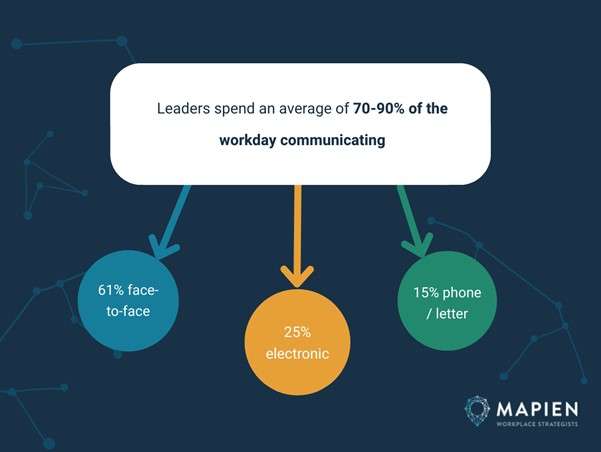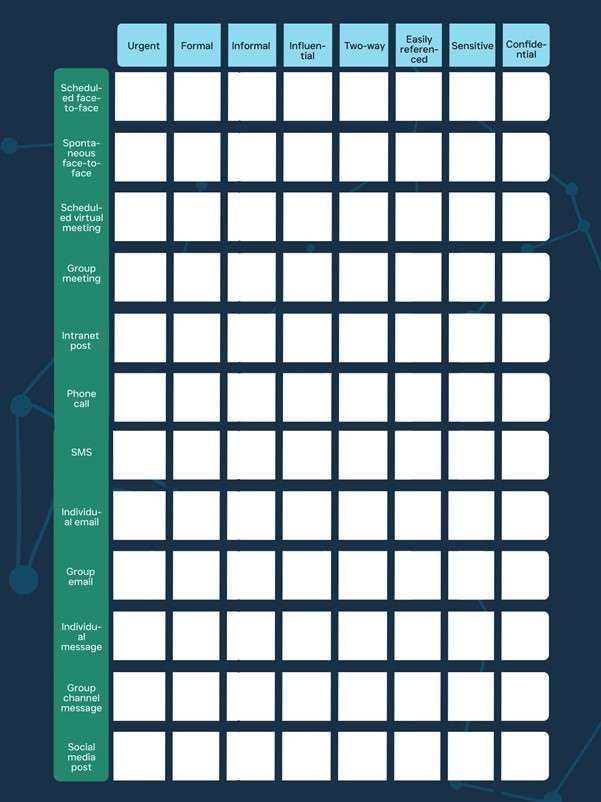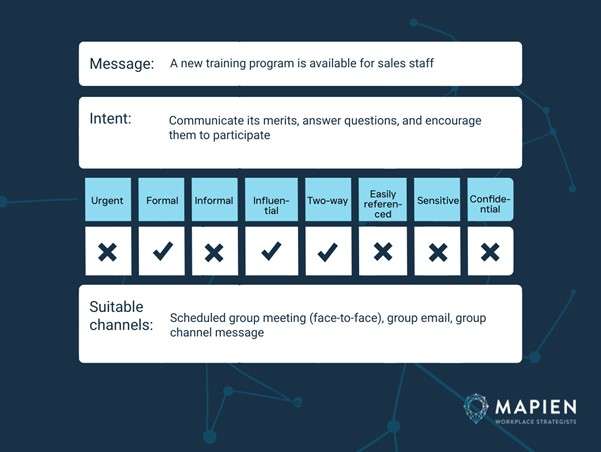
Workplace Communication: Choosing The Right Communication Channel
This is blog #9 in our series on coaching models. Sign up to our mailing list to make sure you don’t miss out on our future content.
Did you know that as a leader, you likely spend anywhere from 70-90% of the work day communicating? If that figure seems like a lot, consider how much time you spend each day in meetings, emails, phone calls, and presentations. It quickly adds up!
One of the most powerful skills you can develop is your ability to communicate effectively — and not only because it occupies the bulk of your time. Good communication is essential for sharing your ideas and your vision, for building trust, and navigating change. On the other hand, poor communication can lead to project delays, failure, low morale, poor performance, and lost sales.
But what many people don’t realise is that good communication is so much more than delivering a clear message. You also need to get the channel right.
Why Choosing the Right Channel Matters

In a study that tracked how CEOs spend their time, they reported that 61% of communication was face-to-face, followed by 24% electronic (like email) and 15% by phone or physical mail.
But as a leader, how do you know what method of workplace communication is most appropriate for the message you need to deliver?
Choosing the right internal communication channel is easier said than done, with so many options available within a modern organisation, such as:
- One-on-one meetings
- Team meetings
- Video calls
- Phone calls
- Emails
- Intranet platforms
- Social media posts
- Messenger applications
Each of these channels has different strengths, weaknesses, and use cases. Choosing the right one is crucial to ensuring your message or communication campaign can achieve the desired outcomes.
8 Considerations for Choosing Your Communication Channels
In order to choose the right methods of communication, you need to match the content and intent of your message with the characteristics of the platform. So, we’ve come up with eight prompts to help you consider your message and your corporate communication channels.
1. How Urgent is the Message?
If you need your message to be seen or acted upon urgently, you’ll need to choose a channel to support that. For instance:
- If all relevant parties working in the same area, urgent messages may be delivered face-to-face
- If all relevant parties are not in the vicinity, it’s standard practice to use phone calls for urgent matters
Note that the opposite rule also applies. If your message is non-urgent, a phone call or unscheduled face-to-face meeting may be seen as disruptive or distracting.
2. Is One-Way or Two-Way Communication Appropriate?
Consider whether your message requires a response or further discussion when choosing your channels. Some communication channels are designed for one-way communication such as announcements or notifications. Other channels are designed to facilitate two-way communication, with features that encourage comments, feedback, and conversation.
Note that in most cases, it’s best to facilitate two-way communication because this shows that you’re open to ideas and listening to your stakeholders. Also, if you choose a channel that doesn’t allow for two-way communication, your stakeholders may still respond, but will choose whatever channel they prefer to reach you on, which can be harder to control or manage.
3. Is Your Goal to Influence People?
Sometimes you’ll need to deliver a message with the goal of influencing an outcome or encouraging buy-in. Generally speaking, if you’re trying to generate more influence and stronger commitments, you’ll have more success if you can deliver the message via face-to-face channels. Plus, face-to-face communication helps to build stronger relationships, ensures you don’t miss important feedback (such as non-verbal cues and social dynamics), and can help you build a more collaborative, engaging environment.
4. How Formal is the Communication?
It’s a good idea to match the level of formality of your message to the level of formality of the channel. You wouldn’t schedule a meeting ahead of time just to talk about what you did on the weekend — and you wouldn’t start a conversation about someone’s end-of-probation performance in the hallway.
You can use this strategically, too — the medium is the message. If you want someone to take you seriously, choose a more serious channel. If you want someone to perceive your message in a more casual way, deliver it in a casual manner.
5. Is the Message Sensitive or Confidential?
Some messages will be of a more sensitive nature or require confidentiality for legal reasons. As such, you’ll need to select a channel where you can control who sees or hears the message.
You should also keep in mind other potential audiences for your message. An obvious example is that a LinkedIn post aimed at internal audiences may also be seen by customers, competitors, future employees, and members of the public. But an internal email, message, or intranet post also has the potential to reach unintended audiences via forwarding or screenshots. For the most sensitive or confidential topics, a private face-to-face meeting is probably the safest option.
6. Will People Need to Refer Back?
Would it be useful for your message to be available for future reference? For example, does it contain useful information that’s relevant to a broader project, piece of work, or audience?
Messages, emails, and discussions are easily lost and forgotten. Instead, you may decide to publish the information as a video or written post in your company-wide intranet so that it’s easy to find and reference in future.
7. What is Your Workplace Communication Culture?
Another consideration is the broader communication culture within your workplace. For instance, are certain methods of communication more prioritised and valued over others? If so, these may be important channels through which to continue your communication, regardless of the message you deliver, any potential discomfort, or any logistical inconvenience.
A further cultural aspect is whether your organisation expects communication to occur at the same time (synchronous) or at different times (asynchronous) for different people. Based on this expectation, certain channels will be more suitable than others.
8. What Does Your Audience Prefer?
Each of the above considerations should be tempered with this final consideration: who are you trying to reach and what do they prefer or expect?
It’s always a good idea to ask your audience about their preferences, either directly or via a survey. And take note of how people respond to your communication via different channels — you’ll soon discover what works best for different audiences.
How to Select Your Channel
We’ve developed a simple model to help you work through the above considerations and hone in on the best channel for your message.
Step 1: Assess Your Channels

The first step to select a communication channel is to reflect on your options. What are the internal communication platforms and methods used in your workplace? And what are their characteristics?
You may like to use or recreate the above matrix template, placing a ✔ or ✖ in each square, based on the characteristics of each channel. This will allow you to see (at a glance) which channels are best suited to different messages and scenarios.
Step 2: What’s Your Message and Intent?

Now reflect on the message and intent of that message. Is it urgent? How formal is it? Does it need to influence people? Do you want to invite feedback or conversation? Will it be referred to in future? And are its contents sensitive or confidential?
Use the matrix from step 2 to determine which communication channels are most appropriate for your message, while keeping in mind your audience preferences and workplace culture.
Step 3: Reflection
After you’ve communicated your message, take some time to reflect on how it went. Was the message or campaign received as intended? What kind of feedback did you get? What would you do differently next time?
If the message wasn’t received as intended, you may need to update your matrix to more accurately reflect your workplace context so that you can choose a more appropriate channel in future.
Get Leadership and Coaching Support
One of the most powerful things you can do is to develop your skills and understanding in communication — especially since so much of your role as a leader is wrapped up in communicating with others.
By working through these considerations and steps identified above, you’ll be all set to confidently choose the right platform for each message.
We’ll be back soon with our final coaching model as we wrap up this series. In the meantime, you can reach out to our team for help with building leadership skills, leadership coaching, and more tools like this one.

